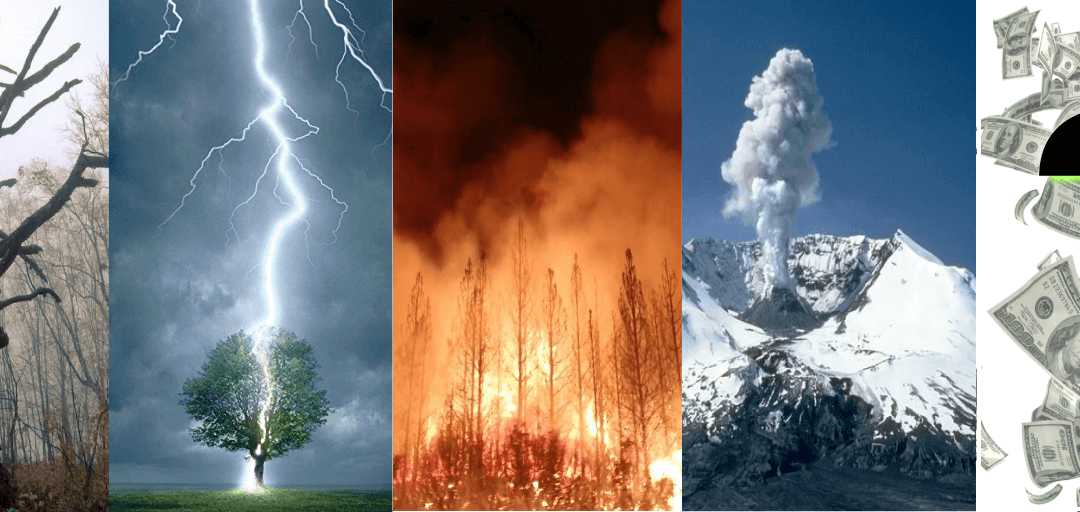BOOM! – At precisely 8:32 a.m. PDT on May 18, 1980, Mount St. Helen’s, a volcanic peak in southwestern Washington state, suffers a massive eruption devastating some 210 square miles of wilderness.
The aftermath is astounding. The land where native forests proudly stood moments ago is now the graveyard for millions of trees tossed like fallen soldiers on a battlefield. Washington state, the lumber industry’s production powerhouse, fights to survive the catastrophic disaster.
This is just one of many examples of natural disasters that immediately impact the economic and environmental stability of the forest industry.
When you witness problems caused by recent natural disasters, you quickly join the scientists, investors, and economists who all wonder the same thing – Can we recover?
Can forests recover from natural disasters?
Absolutely! And the rebound can be stunning. Only 6 months after Mount St. Helen’s blew its top, the destroyed forest began to show signs of life. More than 40 years later, the growth and health of the blast area are arguably better than before.
Over and over again forests and the forest industry show resilience in the face of epic fires, landslides, flooding, harmful pests, disease, climate change, and even volcanic activity.
Natural disasters create investment opportunities
It is no secret that recent natural disasters are hurting forestry’s economic and environmental sectors. Many analysts feel the downward trend may continue for a time.
Amid all the doom and gloom are experienced investors who understand this fact: downward trends create the best investment opportunities.
That’s how fortunes are made in the stock market. Invest when things look grim and reap rewards on the rebounds.
With that in mind, we say, now is a great time to invest in forestry. Here’s how.
Three ways to Invest in forestry after a natural disaster
Invest in the forest.
Most forests rejuvenate without human intervention. But a little help from people speeds the process and scales the rate of success. Reforestation projects… enter stage left.
Reforestation projects
These projects one of the rare moments when human intervention is good for the environment and good for financial profit.
After a disaster, reforestation is typically the first thing that investors from the private, corporate, and governmental sectors pour their resources into. They understand the potential and see the opportunity. You should too.
Invest in the forest industry
Natural disasters create a perfect baseline for analysis, research, and development. Research and development lead to innovation which, in turn, keeps an industry alive. Time and money invested into developing better equipment, strategies, and solutions pay huge dividends in the long run.
The U.S. FOREST SERVICE spends a lot of their budget funding research for “unplanned catastrophic events” and “natural disturbances” that adversely affect the forest. The result? Improved strategies that include genetic diversity, nurseries, seed extractories, forest management, and so on.
Natural disasters also expose weaknesses within the industry. Regarding the incredible price spike of lumber over the past year or so, Newsweek magazine writes, “The coastal wildfires that have hit the U.S. West Coast and part of British Columbia have added to the problem [of lumber shortage and inflation], as did torrential rains that struck the Canadian province late last year–which wiped out several key transportation routes.”
These issues came to the surface because of natural disasters. Investing in improving the weaknesses within the industry contributes toward future stability and profits. This leads to the third, and what we feel is the most important way to invest.
Invest in people
Confucius is given credit for saying, “If you think in terms of a year, plant a seed; if in terms of ten years, plant trees; if in terms of 100 years, teach the people.”
Recent natural disasters have exposed a glaring problem in the wood products supply chain. Saying that there are not enough skilled people in the industry is an understatement. The lack of trained workers is the “Achilles heel” of the industry.
That same Newsweek article writes, “A shortage of workers continues to slow down the supply chain.” Out of all other investment opportunities, using funds to develop a skilled workforce has by far the most impact on recovery from a natural disaster.
How does The Working Forest help you invest in people?
Forbes magazine states, “More than ever before, industry is going to have to become hands-on in resolving the challenge.” Well, thank you Forbes for being “Captain Obvious”, but how to fix this in the real world?
The article continues,” Ways to do that include apprenticeship, collaboration with local schools, better development of internal training, making use of external training resources, and better marketing of manufacturing work as a viable and rewarding career path.”
This is where we come in. The Working Forest liaisons funding, opportunity, and people for the Forestry Industry. Our goal is to increase the quality and quantity of this industry’s skilled workforce. This makes Forestry more resilient to future natural disasters.
If you are involved in the forest industry on the private, corporate, and governmental levels, we will help you find and fund opportunities you can sponsor. Then we will use our platform to market the opportunities you sponsor to people around the world. This is how we amplify the message – the forestry industry is a viable and rewarding career path.
We cannot stop natural disasters from happening, but we can reduce their impact and build resilience by focusing resources on people. In fact, recent natural disasters have created unprecedented opportunities for wise investment and future growth.
Now is the time to invest in people and The Working Forest is the platform that makes that happen.
